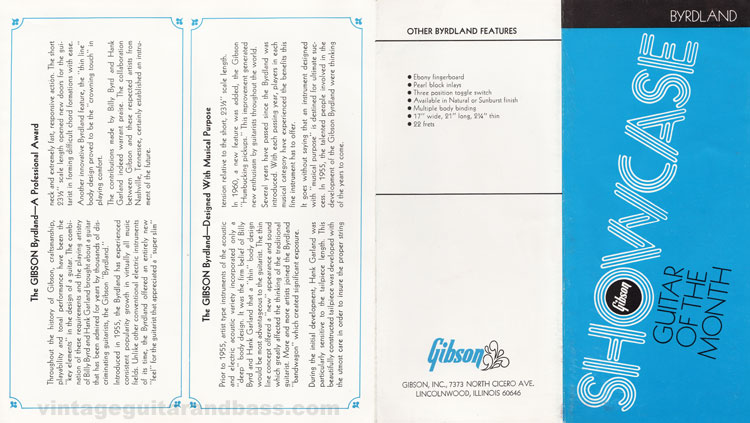
Gibson's 1972 guitar of the month showcase brochures were each dedicated to a single instrument, in this case the thinline jazz guitar, the Gibson Byrdland. A single sheet folded in four; one side (below) consisted of the covers and description, whilst the other unfolded to show a single photo of the Byrdland, with 'outstanding features' detailed.

Throughout the history of Gibson, craftsmanship, playability and tonal performance have been the "key elements" in the design of a guitar. The combination of these requirements and the playing artistry of Billy Byrd and Hank Garland brought about a guitar that has been admired for years by thousands of discriminating guitarists, the Gibson "Byrdland".
Introduced in 1955, the Byrdland has experienced consistent popularity growth in virtually all music fields. Unlike other conventional electric instruments of its time, the Byrdland offered an entirely new "feel" for the guitarist that appreciated a "super slim" neck and extremely fast, responsive action. The short 23 1/2" scale length opened new doors for the guitarist in forming difficult chord formations with ease.
Another innovative Byrdland feature, the "thin line" body design proved to be the "crowning touch" in playing comfort.
The contributions made by Billy Byrd and Hank Garland indeed warrant praise. The collaboration between Gibson and these respected artists from Nashville, Tennessee, certainly established an instrument of the future.
Prior to 1955, artist type instruments of the acoustic and electric acoustic variety incorporated only a "deep" body design. It was the firm belief of Billy Byrd and Hank Garland that a "thin" body design would be most advantageous to the guitarist. The thin line concept offered a "new" appearance and sound which greatly affected the thinking of the traditional guitarist. More and more artists joined the Byrdland, "bandwagon" which created significant exposure.
During the initial development, Hank Garland was particularly sensitive to the tailpiece length. This beautifully constructed tailpiece was developed with the utmost care in order to insure the proper string tension relative to the short, 23 1/2" scale length.
In 1960, a new feature was added, the Gibson "Humbucking pickups". This improvement generated new enthusiasm by guitarists throughout the world. Several years have passed since the Byrdland was introduced. With each passing year, players in each musical category have experienced the benefits this fine instrument has to offer.
It goes without saying that an instrument designed with "musical purpose" is destined for ultimate success. In 1955, the talented people involved in the development of the Gibson Byrdland were thinking of the years to come.
$8995
$8795
€16990